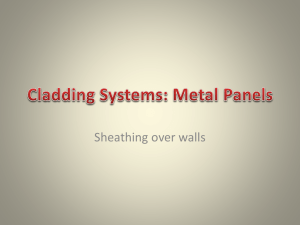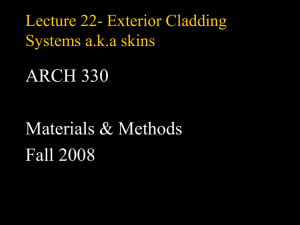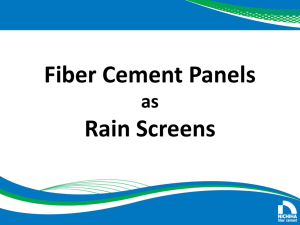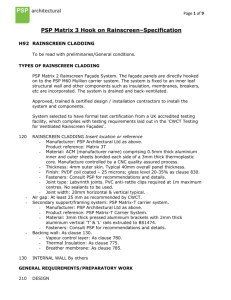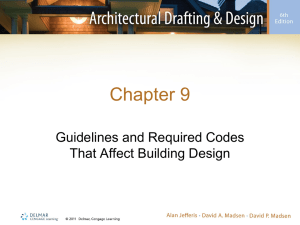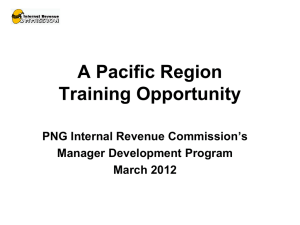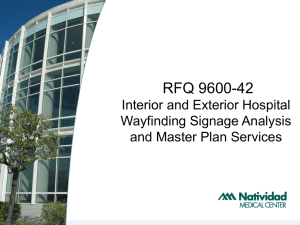Document
advertisement
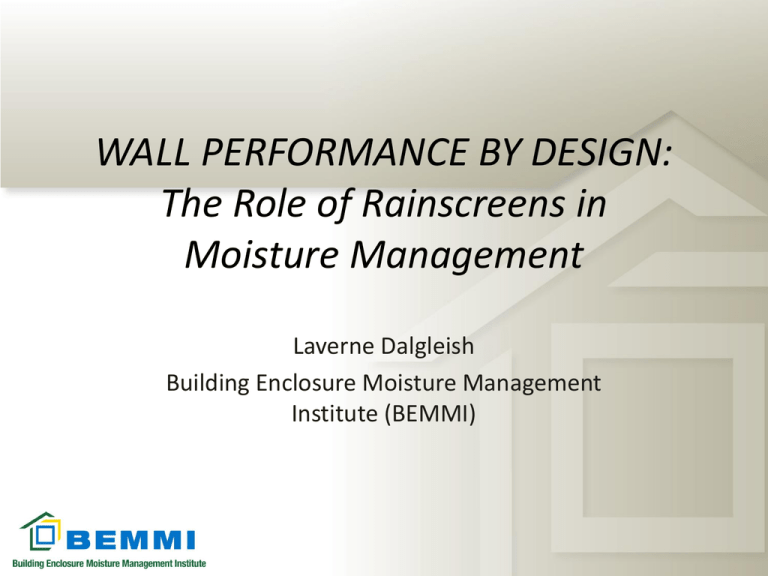
WALL PERFORMANCE BY DESIGN: The Role of Rainscreens in Moisture Management Laverne Dalgleish Building Enclosure Moisture Management Institute (BEMMI) Today’s Agenda • • • • • • • BEMMI Background Exterior Wall Science: As I Live and Breathe! Traditional Rainscreen Design Engineered Rainscreen Design Absorptive Cladding Building Code Requirements and Compliance Bibliography Building Enclosure Moisture Management Institute • Founded in 2009 • Founding Members: – Advanced Building Products – Benjamin Obdyke – Cosella-Dörken – CavClear/Archovations BEMMI Mission To promote the growth of the engineered rainscreen products industry to improve moisture management in building enclosures through technical advocacy Exterior Wall Science: As I Live and Breathe! • Exterior Wall Assembly – Wall Covering Assembly – Water-Resistive Barrier – Insulating Sheathing (continuous insulation) – Structural Framing, Sheathing, Cavity Insulation – Interior Finish Materials • Air Barrier Requirements • Penetrations Traditional Rainscreen Design • Ventilated Cladding – Anchored Brick and Stone Veneers – Wood Shakes and Shingles – Clapboards • Drainage and Drying Traditional Rainscreen Design Absorptive Cladding • • • • • Masonry and Stucco Adhered Veneers Wood Siding Materials Engineered-wood Siding Materials Cement-based Siding Materials Absorptive Claddings Engineered Rainscreen Design • Bulk Water Drainage • Ventilation – – Precipitation, Condensation – Evaporation, Respiration • Capillary Break Space – Isolate Cladding Engineered Rainscreen Design Types of Rainscreen Materials • 3-dimensional membrane • 3-dimensional mesh style • Polymer-based products • Roll out similar to water-resistive barriers • Continuous airspace Engineered Rainscreen Design Engineered Rainscreen Design 0.25 in (6mm) 0.40 in (10mm) Meets Canadian Building Code Engineered Rainscreen Design Engineered Rainscreen Design Code Requirements: 2012 IRC SECTION R703 EXTERIOR COVERING R703.1 General. Exterior walls shall provide the building with a weather-resistant exterior wall envelope. The exterior wall envelope shall include flashing as described in Section R703.8. R703.1.1 Water resistance. The exterior wall envelope shall be designed and constructed in a manner that prevents the accumulation of water within the wall assembly by providing a water-resistant barrier behind the exterior veneer as required by Section R703.2 and a means of draining to the exterior water that enters the assembly. Protection against condensation in the exterior wall assembly shall be provided in accordance with Section R702.7 of this code. Code Requirements: 2012 IRC Exceptions: 1. A weather-resistant exterior wall envelope shall not be required over concrete or masonry walls designed in accordance with Chapter 6 and flashed according to Section R703.7 or R703.8. Code Requirements: 2012 IRC Exceptions (cont.): 2. Compliance with the requirements for a means of drainage, and the requirements of Sections R703.2 and R703.8, shall not be required for an exterior wall envelope that has been demonstrated to resist wind-driven rain through testing of the exterior wall envelope, including joints, penetrations and intersections with dissimilar materials, in accordance with ASTM E 331 under the following conditions: Code Requirements: 2012 IRC 2.1. Exterior wall envelope test assemblies shall include at least one opening, one control joint, one wall/eave interface and one wall sill. All tested openings and penetrations shall be representative of the intended end-use configuration. 2.2. Exterior wall envelope test assemblies shall be at least 4 feet by 8 feet (1219 mm by 2438 mm) in size. Code Requirements: 2012 IRC 2.3 Exterior wall assemblies shall be tested at a minimum differential pressure of 6.24 pounds per square foot (299 Pa). 2.4. Exterior wall envelope assemblies shall be subjected to the minimum test exposure for a minimum of 2 hours. Code Requirements: 2012 IRC Pass / Fail Criteria Exception 2 (cont.): The exterior wall envelope design shall be considered to resist wind-driven rain where the results of testing indicate that water did not penetrate control joints in the exterior wall envelope, joints at the perimeter of openings penetration or intersections of terminations with dissimilar materials. ASTM E331 Water penetration test. Simulates 8” rain / hr. with 50 mph wind. Code Requirements: 2012 IRC • IRC Provides Basic Performance Measures – Minimum Code (minimum legal requirements) • Beyond Code: – Durability – Drainage and Drying – Moisture Management as Preventative Measure Performance Expectations • Help Remove Bulk Water • Promote Drying of Incidental and Absorbed Water • Improve Condensation Management ICC-ES (Evaluation Services) • Meeting the Intent of the Code – ICC-ES Acceptance Criteria: AC356 • • • • • Drainage Test Accelerated Aging & Weathering Durability / Fungi Resistance UV Exposure Fire Resistance (optional) Blower-Door Testing Problem Areas • Tighter the wall, the less it dries • Penetrations and openings create moisture movement issues • Less expensive to address upfront than to fix later Engineered Rainscreen Performance • Drain bulk water from behind the cladding • Provide ventilation drying for other incidental moisture • Separates cladding from WRB – Capillary break – Surfactant issues, enhance WRB durability • Continuously over entire wall surface Engineered Rainscreen Details Rainscreen Material Review • • • • • • • BEMMI Background Exterior Wall Science: As I Live and Breathe! Traditional Rainscreen Design Engineered Rainscreen Design Absorptive Cladding Building Code Requirements and Compliance Bibliography Questions? Bibliography Advanced Building Products Air Barrier Association of America CavClear/Archovations Building Enclosure Moisture Management Institute Benjamin Obdyke Cosella-Dörken International Code Council, Evaluation Services International Code Council Masonry Veneer Manufacturers Association NAHB Research Center White Paper www.mortairvent.com www.airbarrier.org www.cavclear.com www.bemmi.org www.benjaminobdyke.com www.cosella-dorken.com www.icc-es.org www.iccsafe.org www.masonryveneer.org www.toolbase.org/PDF/DesignGuides/RainScreenDesigns.pdf
